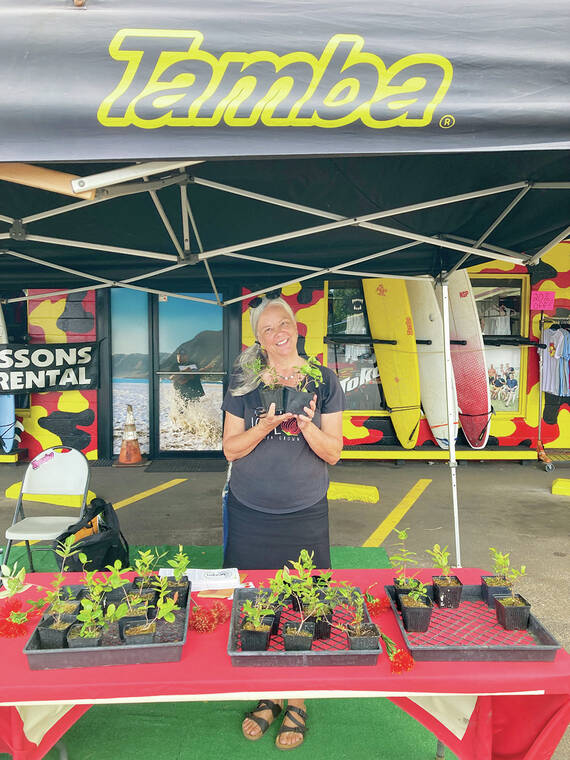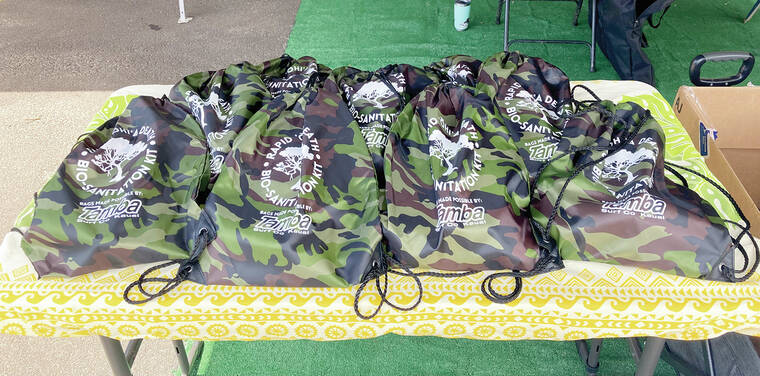KAPA‘A — Kauaians of all kinds celebrated ‘Ohi‘a Lehua Day on Monday, with a seedling giveaway at Tamba Surf Company in downtown Kapa‘a.
Kim Rogers of the Kaua‘i Invasive Species Committee, and volunteer Karyle Soto provided a near-constant stream of community members with ‘ohi‘a keiki and bio-sanitation kits throughout the day.
‘Ohi‘a lehua (Metrosideros polymorpha) is endemic to the Hawaiian islands, and is arguably one of Hawai‘i’s most iconic plants.
“I often refer to ‘ohi‘a as ‘the tree of life,’” Rogers, the KISC rapid ‘ohi‘a death outreach specialist, told The Garden Island. “This modest tree — that so many people walk by in the forest and really don’t even take notice of — is so important to our lives, from the water that we drink everyday to providing home for other flora and fauna.”
Rogers’ words were borne out by the variety of people around her, outside the Tamba storefront.
Tamba Office Manager Barry Klein knows healthy forests mean healthy reefs because ‘ohi‘a trees prevent erosion. (This land-and-sea connection has led Tamba and its community of surfers to become enthusiastic supporters of ‘ohi‘a conservation. Tamba and Koloa plant nursery Pulu donated $6,000 to local rapid ‘ohi‘a death response in January.)
Others said they value ‘ohi‘a as lei-making material and bird habitat, acknowledging it as one of many native plants threatened by invasive species or disease.
“We love to make hakus and leis with the ‘ohi‘a,” said Wailua Homesteads resident Tiani Kaui, who picked up a seedling with her mother, Mahea.
Krista Brodie’s stock-in-trade is koa (Acacia koa), another endemic tree species.
Now, Brodie, of the Kaua‘i Koa Farm mauka of Princeville, wants to add ‘ohi‘a to the farm’s groves. The seedling she received Monday will be one of the first.
“We want to have all the endemic trees that we possibly can,” Brodie said. “‘Ohi‘a will add a lot more habitat, I hope … I want to attract the red bird, the ‘i‘iwi (Drepanis coccinea).”
But ‘ohi‘a remains threatened by ROD, a disease caused by fungal pathogens. Both funguses — Ceratocystis lukuohia and the less-aggressive C. huliohia — were first reported on Kaua‘i in 2018.
Most recently, in February, the state Department of Land and Natural Resources announced ROD killed a tree on the Alaka‘i Plateau. The discovery marked the first confirmed incursion of ROD in the wilderness area.
The bio-sanitation kits distributed by KISC and funded by Tamba contain rubbing alcohol, spray-bottles and boot brushes. The tools prevent the inadvertent spread of ROD-causing spores when used to clean to hikers’ dirty footwear and equipment.
On Kaua‘i, ‘ohi‘a lehua is often associated with the upland region of Koke‘e, according to Rogers.
However, this seemingly limited range has not always been case, she continued.
Monday’s seedling receipients can grow their ‘ohi‘a wherever they may live, with proper care. The trees can even be kept in pots.
“This tree, at one time, grew in our backyards,” Rogers said. “And can it can grow in our backyards again.”
•••
Scott Yunker, reporter, can be reached at 245-0437 or syunker@thegardenisland.com.



